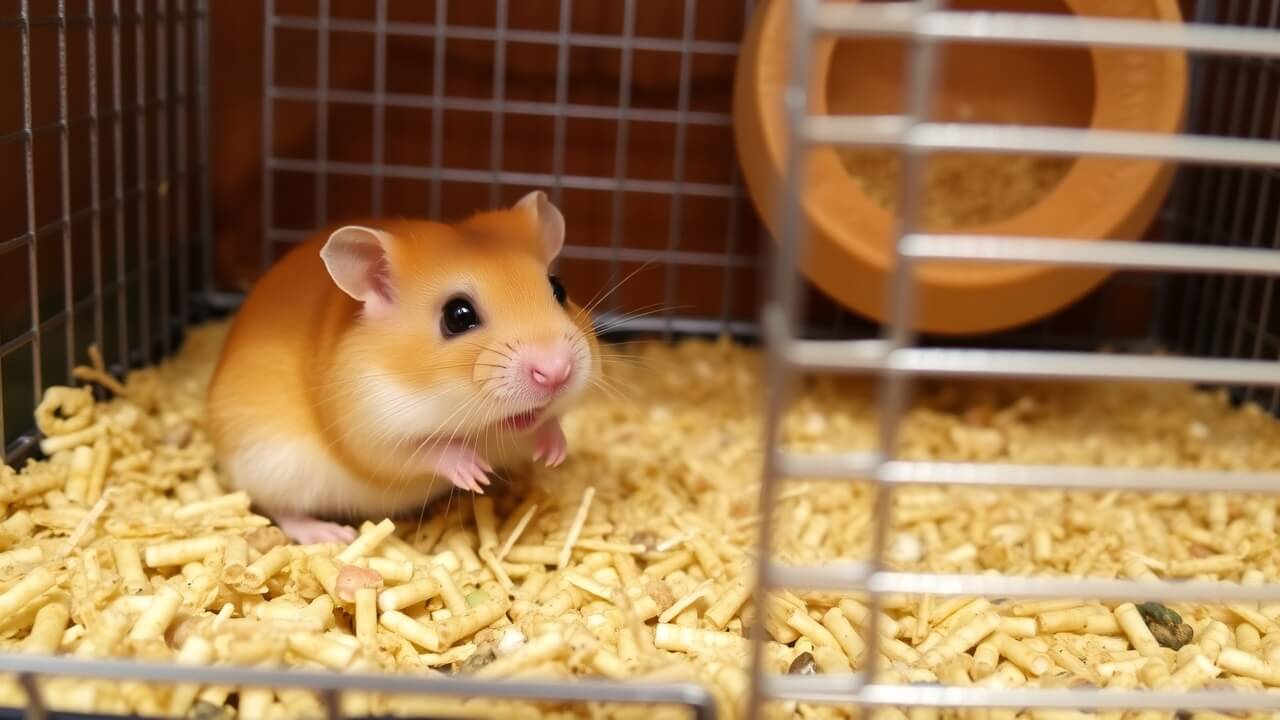
Fleas pose significant health risks to hamsters and their owners. These blood-feeding parasites cause discomfort and irritation, potentially leading to anemia, skin infections, and disease transmission in hamsters. Severe infestations may result in hair loss and open wounds due to excessive scratching, increasing the risk of secondary infections.
Hamster owners should be aware of these dangers to implement effective prevention and treatment strategies. Flea infestations in hamsters can also impact human health. Some flea species can transmit diseases to humans, including typhus and plague.
While the risk of contracting these diseases from hamster fleas is relatively low, it is essential to take precautions to protect both the pet and the household. Understanding the potential dangers associated with flea infestations enables hamster owners to implement appropriate measures to control these parasites and maintain the health of their pets and families.
Key Takeaways
- Flea infestations can pose serious health risks to your hamster, including anemia and skin irritation.
- Look for tiny, fast-moving insects on your hamster’s fur, as well as excessive scratching and hair loss, to identify flea infestations.
- Symptoms of flea troubles in hamsters may include restlessness, irritability, and visible bite marks on the skin.
- Regularly clean your hamster’s living environment and use flea prevention products to keep fleas away.
- Consult a veterinarian for safe and effective flea treatment options for your hamster, and follow their guidance closely.
Identifying Flea Infestations: How to Spot Fleas on Your Hamster
Behavioral Changes
One of the most obvious signs is excessive scratching and biting at the skin, as fleas cause irritation and discomfort for their host.
Physical Signs
You may also notice small red bumps or scabs on your hamster’s skin, which are a result of flea bites. Additionally, if you part your hamster’s fur and see small black specks that resemble dirt, this may actually be flea dirt, which is a combination of flea feces and dried blood.
Detection Methods
Another way to identify flea infestations on your hamster is to use a fine-toothed comb to carefully comb through your hamster’s fur. If you notice tiny black or brown insects jumping or crawling on the comb, these are likely fleas. It’s important to act quickly if you suspect that your hamster has fleas, as these parasites can quickly multiply and lead to a full-blown infestation if left untreated. By knowing how to spot fleas on your hamster, you can take immediate action to address the problem and prevent further discomfort for your pet.
Signs of Distress: Recognizing the Symptoms of Flea Troubles in Your Hamster

Flea infestations can cause a range of distressing symptoms in your hamster, so it’s important to be vigilant and recognize the signs of flea troubles. In addition to excessive scratching and biting at the skin, your hamster may exhibit signs of restlessness or agitation. This is often a result of the discomfort caused by flea bites and irritation.
You may also notice that your hamster’s fur appears unkempt or matted, as constant scratching can lead to hair loss and skin damage. Additionally, if your hamster seems lethargic or uninterested in activities that they usually enjoy, this may be a sign that they are feeling unwell due to flea infestations. Another common symptom of flea troubles in hamsters is anemia, which occurs when fleas feed on their host’s blood, leading to a decrease in red blood cells.
Anemic hamsters may appear weak or listless, and their gums and mucous membranes may appear pale. If you notice any of these symptoms in your hamster, it’s important to take immediate action to address the flea infestation and provide relief for your pet. By recognizing the signs of distress caused by flea troubles, you can ensure that your hamster receives the care and attention they need to recover from this common parasite.
Preventative Measures: Keeping Fleas Away from Your Hamster
Preventing flea infestations is key to keeping your hamster healthy and happy. There are several preventative measures you can take to keep fleas away from your hamster and their environment. One of the most important steps is to regularly clean and sanitize your hamster’s cage and accessories.
This includes removing soiled bedding, food debris, and any potential hiding spots for fleas. Regularly washing and disinfecting your hamster’s cage will help prevent flea infestations from taking hold in their living space. Another important preventative measure is to regularly groom and inspect your hamster for signs of fleas.
Using a fine-toothed comb to carefully comb through your hamster’s fur can help you spot fleas or flea dirt before an infestation takes hold. Additionally, providing your hamster with a clean and comfortable living environment, as well as a healthy diet and regular exercise, can help boost their immune system and make them less susceptible to flea infestations. By taking proactive measures to keep fleas away from your hamster, you can help ensure that they stay healthy and happy.
Treatment Options: How to Safely Rid Your Hamster of Fleas
If you suspect that your hamster has fleas, it’s important to take immediate action to safely rid them of these parasites. There are several treatment options available for treating flea infestations in hamsters. One option is to use a specially formulated flea treatment designed for small animals, such as spot-on treatments or flea sprays that are safe for use on hamsters.
It’s important to carefully follow the instructions provided with these treatments and consult with a veterinarian if you have any concerns about their safety or effectiveness. Another treatment option for flea infestations in hamsters is to carefully bathe them using a mild shampoo that is safe for small animals. This can help remove fleas and flea dirt from their fur, providing immediate relief from itching and discomfort.
However, it’s important to use caution when bathing your hamster, as they are sensitive animals that can easily become stressed or injured if not handled properly. If you’re unsure about how to safely bathe your hamster or have concerns about their reaction to water, it’s best to consult with a veterinarian for guidance.
Seeking Veterinary Care: When to Consult a Professional for Flea Infestations
Professional Guidance and Medication
A veterinarian can provide professional guidance on the best course of treatment for your hamster’s specific needs, as well as prescribe safe and effective medications for treating fleas. They can help you identify the underlying causes of the infestation and develop a comprehensive treatment plan to eliminate the fleas and prevent future infestations.
Multi-Pet Households and Home Infestations
Additionally, if you have multiple pets in your household or suspect that your home may be infested with fleas, it’s crucial to consult with a veterinarian for advice on how to address the problem effectively. Flea infestations can quickly spread from one pet to another and throughout your home, so it’s vital to take swift action to prevent further infestations and protect the health of all your pets.
Ensuring the Best Possible Treatment and Recovery
By seeking veterinary care for flea infestations in your hamster, you can ensure that they receive the best possible treatment and support for their recovery. A veterinarian can provide personalized care and attention to help your hamster recover from the infestation and prevent future occurrences.
Maintaining a Flea-Free Environment: Tips for Keeping Your Hamster Healthy and Happy
Once you have successfully treated your hamster for fleas, it’s important to take steps to maintain a flea-free environment in order to prevent future infestations. Regularly cleaning and sanitizing your hamster’s cage and accessories is crucial for keeping fleas away from their living space. This includes washing bedding, toys, food dishes, and any other items in their cage on a regular basis.
Additionally, vacuuming and cleaning the areas where your hamster spends time outside of their cage can help prevent fleas from taking hold in your home. Another important aspect of maintaining a flea-free environment is to regularly groom and inspect your hamster for signs of fleas. Using a fine-toothed comb to carefully comb through their fur can help you spot fleas or flea dirt before an infestation becomes established.
Additionally, providing your hamster with a healthy diet, regular exercise, and plenty of mental stimulation can help boost their immune system and make them less susceptible to flea infestations. By taking proactive measures to maintain a flea-free environment for your hamster, you can help ensure that they stay healthy and happy for years to come. In conclusion, flea infestations can pose a serious threat to the health and well-being of your hamster.
By understanding the potential dangers of fleas, knowing how to spot them on your pet, recognizing the signs of distress caused by flea troubles, taking preventative measures, using safe treatment options when necessary, seeking veterinary care when needed, and maintaining a flea-free environment, you can ensure that your hamster stays healthy and happy while keeping these pesky parasites at bay.






